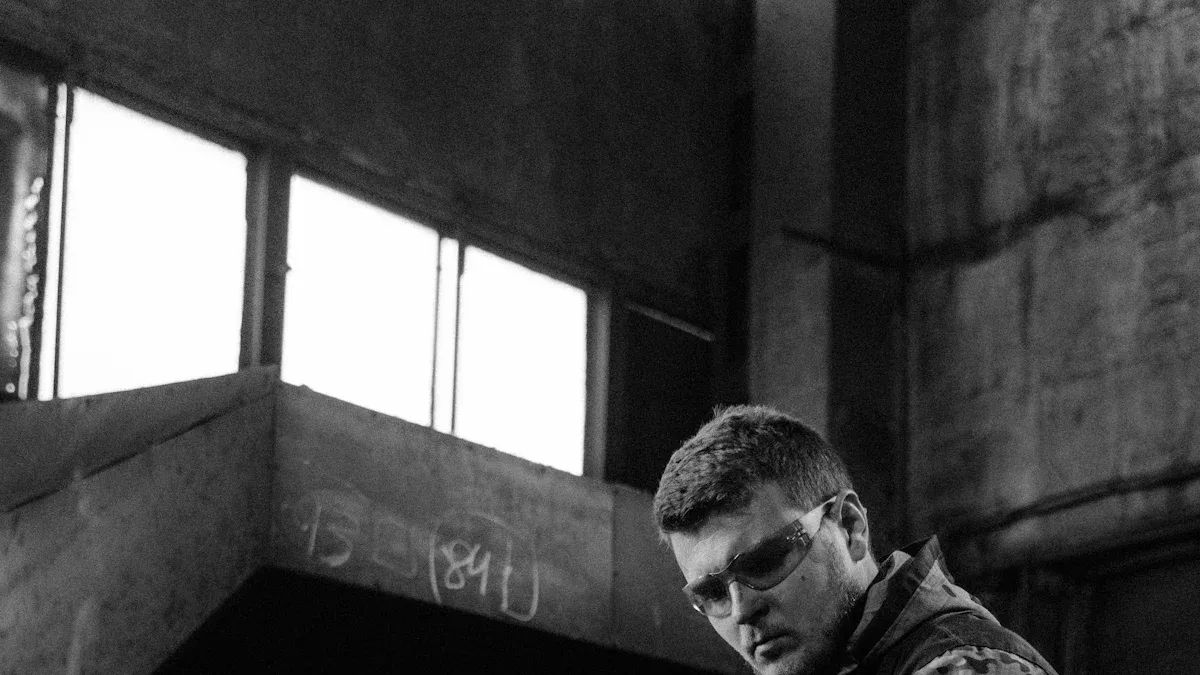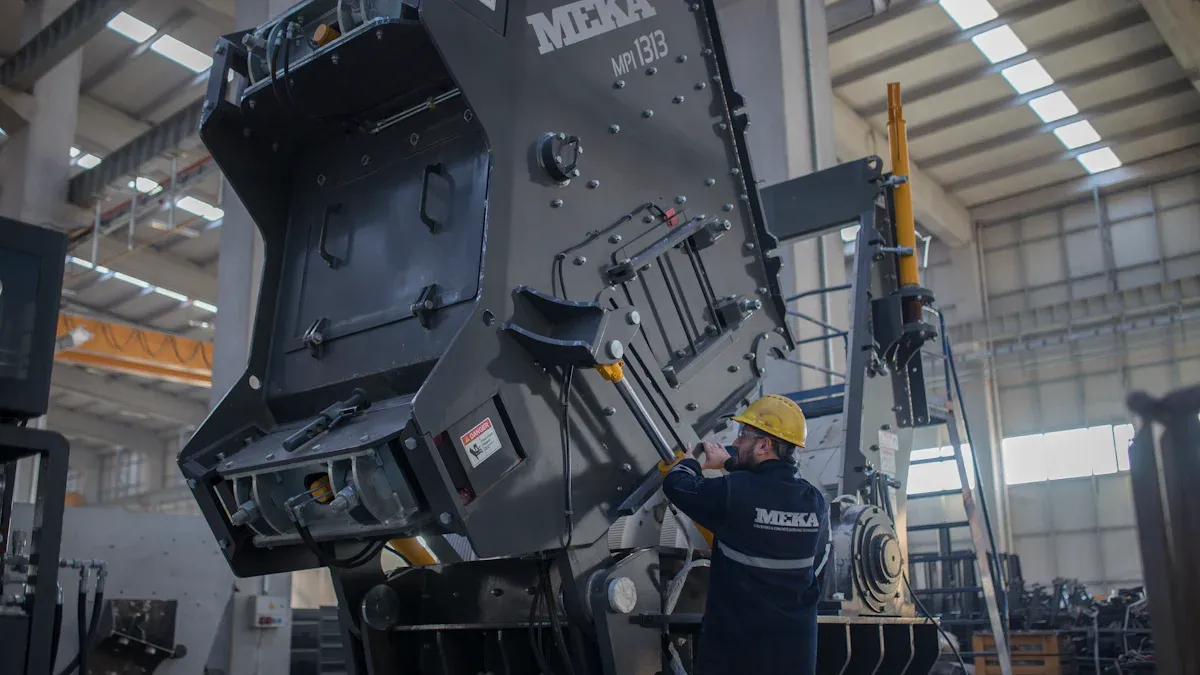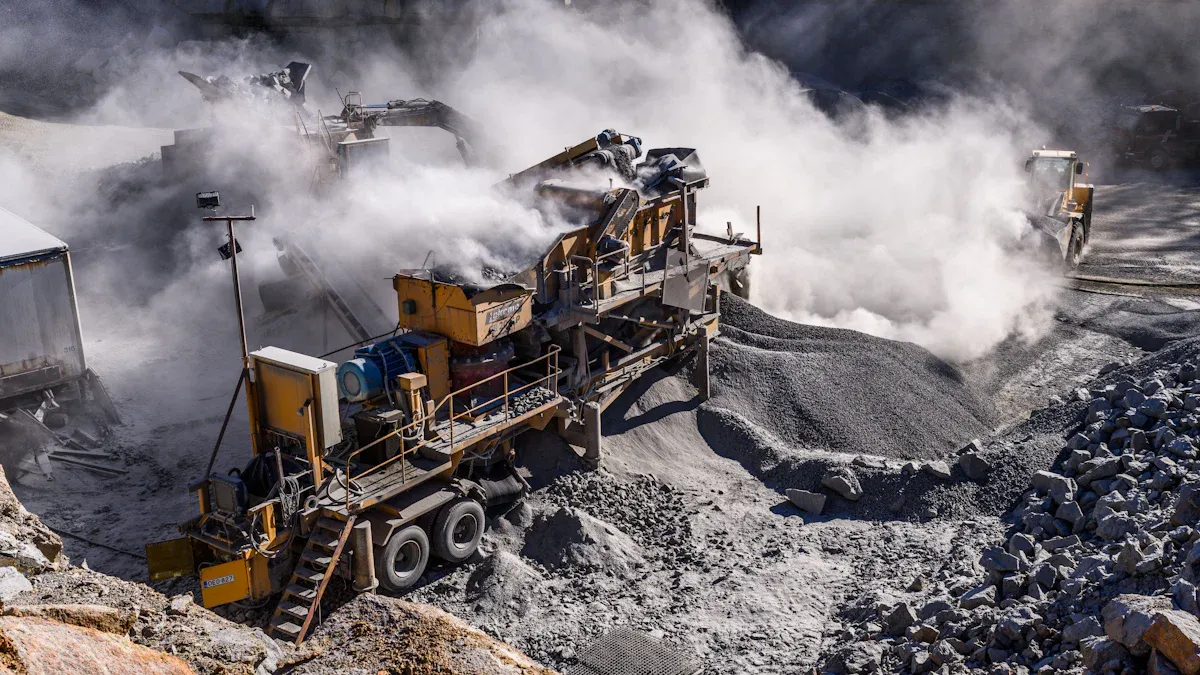
Maintaining the wear parts of your hammer crusher ensures peak performance and fewer mechanical failures. Research shows that timely maintenance reduces downtime and increases efficiency. Regular replacement of screens and hammers prevents costly delays caused by vibration issues. By prioritizing upkeep, you extend your equipment’s lifespan and boost production rates.

Understanding the common wear issues in hammer crusher parts helps you maintain your equipment effectively. Wear and tear are inevitable in any machinery, but identifying the key wear parts, understanding the causes, and recognizing the signs of wear can significantly reduce downtime and improve performance.
A hammer crusher consists of s
everal components that experience wear during operation. The most commonly affected parts include:
- Hammers: These are the primary components that crush materials. They endure severe impact and abrasion.
- Blow Bars: These parts face high wear rates, especially at the center, due to uneven material feeding.
- Grates: These control the size of the output material and often wear out due to constant contact with crushed materials.
- Rotor: This part rotates the hammers and is subject to mechanical stress and fatigue over time.
Wear on these parts can lead to reduced efficiency and increased maintenance costs. For example, studies show that blow bars experience varying wear rates depending on their position. The center of the bar often wears faster due to non-uniform feeding, with wear rates as high as 0.000194 mm/ton. Adjusting the feed rate can reduce this to 0.000114 mm/ton, extending the lifespan of the blow bars.
Several factors contribute to wear in hammer crusher components. These include:
- Material Properties: Hard and abrasive materials cause more wear than softer ones.
- Feeding Practices: Uneven or excessive feeding increases stress on the hammers and blow bars.
- Mechanical Stresses: Fatigue fractures and impact-abrasion are common in hammer mills, especially in the rotor and hammers.
- Improper Maintenance: Neglecting regular inspections and lubrication accelerates wear.
Research highlights that redesigned hammers with optimized materials and structures can reduce wear rates from 0.037 g/h to 0.023 g/h. This demonstrates the importance of selecting the right materials and maintaining proper operational parameters.
Recognizing the signs of wear early can prevent costly breakdowns. Look for these indicators:
- Increased Vibration: This often signals rotor imbalance or worn hammers.
- Abnormal Noise: Loud or unusual sounds may indicate loose bolts, broken liners, or foreign objects in the crusher.
- Reduced Efficiency: Larger particle sizes or uneven discharge suggest worn grates or hammers.
- Overheating Bearings: High temperatures in the bearings could result from insufficient lubrication or misalignment.
Maintenance logs reveal that common malfunctions, such as excessive vibration or abnormal noise, often stem from worn or improperly installed parts. For example, replacing worn hammers and tightening bolts can resolve these issues and restore normal operation.
| No. | Common Malfunctions | Cause | Solution |
|---|---|---|---|
| 1 | Excessive vibration | Rotor imbalance, loose bolts | Tighten bolts, balance rotor, replace worn hammers |
| 2 | Abnormal noise | Broken liners, foreign objects | Remove objects, replace liners |
| 3 | Reduced efficiency | Worn grates, excessive hammer wear | Replace grates and hammers |
| 4 | Overheating bearings | Insufficient lubrication, misalignment | Add oil, clean bearings, realign components |
By addressing these issues promptly, you can minimize downtime and maintain the peak performan ce of your hammer crusher.

Regular inspections are essential for keeping your hammer crusher in top condition. By examining wear parts frequently, you can identify potential issues before they escalate into costly repairs. Inspections help you detect cracks, uneven wear, or loose components that could compromise the crusher's performance.
Create a checklist for your inspections. Include items like hammer wear, rotor alignment, and grate condition. Pay close attention to the hammers and blow bars, as these parts endure the most stress. For example, uneven wear on the blow bars often indicates improper feeding practices. Addressing such issues early can prevent further damage and extend the lifespan of your equipment.
Tip: Schedule inspections during planned downtime to avoid disrupting production. This proactive approach minimizes unexpected failures and keeps your operations running smoothly.
Cleaning and lubrication play a vital role in maintaining your hammer crusher. Dust and debris can accumulate on wear parts, causing unnecessary friction and reducing efficiency. Regular cleaning removes these contaminants, ensuring smooth operation. Use compressed air or a soft brush to clean delicate components like bearings and seals.
Lubrication reduces friction between moving parts, preventing overheating and wear. Apply the recommended lubricant to the bearings, rotor, and other critical areas. Follow the manufacturer's guidelines for the type and frequency of lubrication. Over-lubricating can attract dust, while under-lubricating may lead to premature failure.
Note: Always clean the parts thoroughly before applying lubricant. This ensures the lubricant adheres properly and provides maximum protection.
Proper installation and alignment are crucial for the efficient operation of your hammer crusher. Misaligned components can cause excessive vibration, uneven wear, and reduced efficiency. Ensure all parts are installed according to the manufacturer's specifications. Use alignment tools to verify that the rotor and hammers are correctly positioned.
Studies show that modern alignment techniques significantly improve crusher performance. For instance:
- A test stand evaluated the impact of hammer mill design on grinding efficiency.
- Advanced tools like torque meters and two-channel meters revealed that a new rotor design outperformed traditional designs.
- Statistical analysis highlighted the economic and technological benefits of proper alignment.
Follow these recommendations for optimal results:
1. Maintain a drum rotational speed of 2250 rpm for fine milling.
2. Keep grain moisture content at 10% to enhance efficiency.
3. Use hammers with a thickness of 5mm to improve performance.
By ensuring proper alignment, you reduce wear and maximize the crusher's output.
Preventive maintenance is the cornerstone of long-term equipment reliability. Instead of waiting for parts to fail, schedule regular maintenance to address potential issues. Develop a maintenance plan that includes inspections, cleaning, lubrication, and part replacements.
Set specific intervals for each task based on the crusher's operating conditions. For example, high-volume operations may require more frequent maintenance than smaller facilities. Keep detailed records of all maintenance activities. These logs help you track wear patterns and predict when parts will need replacement.
Tip: Train your team to recognize early signs of wear and perform basic maintenance tasks. This reduces downtime and ensures your hammer crusher operates at peak efficiency.
Choosing high-quality materials for your hammer crusher parts ensures durability and reliable performance. Materials with superior wear resistance and hardness last longer, reducing the frequency of replacements. Laboratory tests confirm this. For example:
- Mass loss measurements during abrasion wear tests showed values below 0.1g for high-quality materials.
- Composite layers reinforced with tungsten carbides demonstrated wear resistance 2 to 6 times higher than standard materials.
These results highlight the importance of investing in premium materials. High-quality parts not only withstand harsh conditions but also improve the crusher's efficiency, saving you time and money in the long run.
When replacing parts, you often face a choice between OEM (Original Equipment Manufacturer) and aftermarket options. OEM parts are designed specifically for your equipment, ensuring a perfect fit and optimal performance. Lifecycle cost analyses reveal that OEM parts reduce long-term expenses by improving efficiency and minimizing downtime. Additionally, partnering with OEM experts provides access to proactive maintenance and upgrades.
Aftermarket parts may seem cost-effective initially, but they often lack the same quality assurance. This can lead to frequent replaceme nts and higher maintenance costs over time. Prioritize OEM parts to maximize the lifespan and reliability of your hammer crusher.
Finding a trustworthy supplier is crucial for maintaining your equipment. Reliable suppliers adhere to strict quality standards and provide consistent performance. Look for suppliers who:
- Offer material certifications, such as ISO 9001 and ASTM compliance.
- Conduct quality control processes, including inspections and performance testing.
- Have a strong reputation for timely delivery and customer support.
Databases like Cemspare evaluate supplier reliability based on these benchmarks. They also perform in-house inspections and third-party tests to ensure compliance with technical standards. Partnering with such suppliers guarantees access to high-quality parts that meet your operational needs.
Maintaining your hammer crusher wear parts ensures optimal performance and cost savings. Proactive care reduces energy consumption by up to 1.89 times compared to traditional crushers. It also boosts productivity to 1,440 kg/h. By adopting these practices, you enhance efficiency, lower costs, and extend your equipment’s lifespan.
Regular inspections, proper cleaning, and timely lubrication help extend the lifespan. Replace worn parts promptly to avoid further damage and ensure efficient operation.
Tip: Follow the manufacturer’s maintenance schedule for optimal results.
Inspect wear parts weekly or after every 40 hours of operation. High-volume operations may require more frequent checks to prevent unexpected failures.
Yes, but OEM parts fit better and last longer. Aftermarket parts may save money initially but often lead to higher maintenance costs over time.
Note: Always verify the quality of aftermarket parts before purchasing.